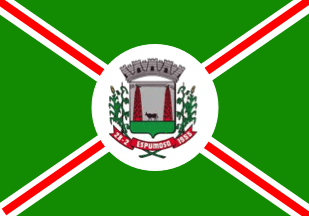 image by Ivan Sache, 17 July 2020
image by Ivan Sache, 17 July 2020

Last modified: 2020-07-18 by ian macdonald
Keywords: rio grande do sul | espumosa |
Links: FOTW homepage |
search |
disclaimer and copyright |
write us |
mirrors
 image by Ivan Sache, 17 July 2020
image by Ivan Sache, 17 July 2020
The municipality of Espumosa (15,240 inhabitants; 78,307 ha) is located 275
km north of Porto Alegre. The municipality is composed of the districts of
Espumosa (seat), Avelino Paranhos (est. by Municipal Law No. 168 promulgated on
28 November 1961), Campina Redonda (est. by Municipal Law No. 330 promulgated on
20 March 1966), Depósito (est. by Municipal Law No. 179 promulgated on 30
November 1961), and Volta Alegre (est. by Municipal Law No. 177 promulgated on
16 March 1962).
Espumosa was established as a district of Soledade by
Municipal Act No. 2 issued on 19 September 1892. The place (lt., Foamy) was
named after abundant foam formed in river Jacuí by different waterfalls.
Subsequently renamed to Borges de Medeiro, the district was renamed to Espumosa
by State Decree No. 7,199 issued on 31 March 1938.
The municipality of
Espumosa was established by State Law No. 2,554 promulgated on 18 December 1954.
https://Espumosa.rs.gov.br/
Municipal website
Ivan Sache, 17 July 2020
The flag and arms of Espumosa are prescribed by Municipal Law No. 617
promulgated on 24 September 1971.
Article 6.
The municipal flag of
Espumosa, designed by the heraldist Arcinoé Antonio Peixoto de Faria, shall be
quartered in saltire, the green quarters being composed by four white stripes
charged with red stripes, arranged two by two per bend and per bend sinister,
starting from a central white circle charged with the municipal coat of arms.
§1. The style of the flag obeys the traditions of Portuguese heraldry and
its inherited canons and rules, prescribing municipal flags to be divided in
eight or six horizontal stripes, quartered or divided in three parts; here was
adopted the quartered per saltire style, composed of stripes that start from the
flag's corners and cross in center, charged with a white circle inscribing the
coat of arms.
§2. The coat of arms applied on the flag's center represents
the municipal government while the white circle represents the town proper as
the municipal seat. The stripes symbolize the spread of municipal power all over
the territory. The quarters represent the rural estates scattered over the
municipal territory.
Article 7.
In compliance with heraldic rules, the
municipal flag shall have the official dimensions adopted for the national flag,
14 units in width on 20 units in length.
Article 19.
The coat of arms
of Espumosa, designed by the heraldist Arcinoé Antonio Peixoto de Faria,is
described as follows:
"A Samnit shield surmounted by an eight-towered mural
crown argent. Argent issuant from a barrage vert and surrounded by an oxen pass
ant sable two electric pylons gules. The shield supported dexter and sinister by
wheat and soybean plants proper crossed in base and superimposed by a scroll
gules containing in letters argent the toponym "ESMPUMOSO" surrounded by the
date "26. - 2(ic) - 1955".
The coat of arms has the following symbolic
interpretation:
a) The Samnit shield, used to represent the arms of Arfas de
Espumosa, was the first style of shield introduced to Portugal under French
influence, inherited by Brazilian heraldry to evoke the colonizing race and main
builder of the nation;
b) The mural crown surmounting the shield is the
universal symbol of coats of arms of domains; argent (silver) with eight towers,
five visible in perspective, it classifies the town as of second rank or county
seat.
c) Argent (silver) is a symbol of peace, friendship, work, prosperity,
purity and religious feeling.
d) Issuance from a base vert (green), the
electric pylons gules (red) identify on the coat of arms the production of
electric energy that yielded to Espousal the nickname of Capital of Electric
Energy. The oxen pass ant sable (black) represents cattle-breeding, a source of
income of the highest significance for the municipality.
e) Vert (green) is a
symbol of honor, civility, courtesy, glee, abundance and hope; green also
represents the greening fields in spring promising profuse harvests; gules (red)
is a symbol of dedication, patriotic love, audacity, intrepidity, courage,
valiance; sable is a symbol of moderation, austerity, prudence and wisdom.
f)
The outer ornaments, wheat and soybean, represent the main products of the
generous and fertile soil, which also contribute to the municipal income.
g)
On a scroll gules in argent (silver) letters the identifying toponym "Espumosa"
surrounded by the date of emancipation, "28 - 2 - 1.955".
https://leismunicipais.com.br/a/rs/e/Espumosa/lei-ordinaria/1971/62/617/lei-ordinaria-n-617-1971-dispoe-sobre-a-forma-e-a-apresentacao-dos-simbolos-do-municipio-de-Espumosa-e-da-outras-providencias
Leis Municipais database
Ivan Sache, 17 July 2020